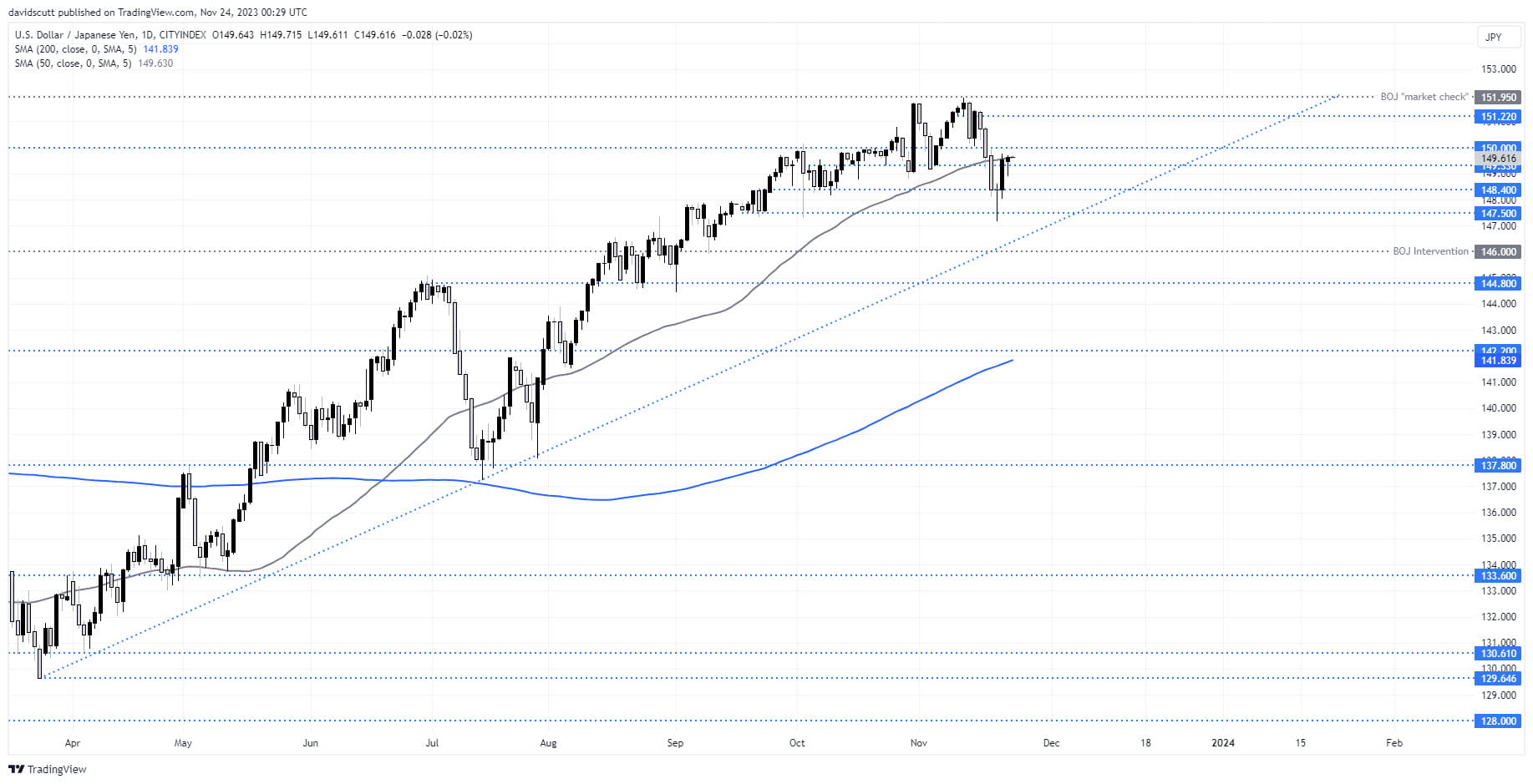USD/JPY traders barely acknowledged the release of Japan’s October inflation report, reinforcing the view the only thing that matters for the pair right now is developments in the US economy, unless the Bank of Japan (BOJ) signals or starts to normalise monetary policy.
By :David Scutt, Market Analyst
- Japan released inflation data for October on Friday, but markets ignored it
- Until the BOJ can signal a normalisation of policy settings, it means offshore factors are likely to drive movements in USD/JPY
- Looking ahead, US flash PMI data out later in the session could generate volatility in USD/JPY
USD/JPY traders barely acknowledged the release of Japan’s October inflation report on Friday, reinforcing the view the only thing that matters for the pair right now is developments in the US economy, unless the Bank of Japan (BOJ) signals or starts to normalise monetary policy settings.
Japanese inflationary pressures ease
According to the Japanese government, headline inflation rose 3.3% from a year earlier, up from 3% reported in September. Core inflation, which is far more important when it comes to interest rate settings, rose by a tenth of a percent to 2.9%, undershooting the 3% increase expected. Excluding fresh food and energy priced, so called ‘core core’ inflation rose 4%, double the BOJ’s mandate but down two tenths on the 4.2% pace reported a month earlier.
The economy isn’t helping the BOJ
While inflation at the consumer level remains well above the BOJ’s 2% target, underlying inflationary pressures are clearly moderating, mirroring similar trends in upstream price pressures facing businesses. Economic growth is also flagging, weighed by sluggish consumer spending and business investment.
Earlier this week, the Japanese government downgraded its view on the domestic economy for the first time this year, noting the pace of recovery was “pausing”.
“While business conditions and firms’ earnings continue to improve, the strength of the corporate sector is not necessarily translating into wages and investment,” the government said. “Domestic demand such as corporate investment and consumer spending lack strength.”
Nor is the threat of yen strength next year
The difficult environment underscores the challenge facing the BOJ, having to wait for more concrete evidence that higher inflation is flowing through to wage demands before considering normalising monetary policy. If and when it reaches that point, widely deemed to be around the start of the fiscal year in April, the bank may face the added complication that other central banks are on the cusp of easing policy, creating conditions that could see the yen appreciate against a basket of currencies, including the USD. It also explains why movements in the JPY against other currency pairs largely reflect what’s happening offshore right now, rather than Japan.
USD/JPY sticking close to the 50DMA
With that unlikely to change anytime soon, it means USD/JPY traders should be watching developments far more closely in the US economy for clues as to what the Fed and interest rate differentials may do in 2024. With that in mind, the US flash composite PMI report for November released later in the session looms as a potential catalyst for volatility in USD/JPY. With markets on edge when it comes to relative growth outlooks, any further signs the US is weakening may further compress yield differentials with Japan, adding to the downside already seen in recent weeks.

Looking at USD/JPY on the daily, price is sticking close to the 50-day moving average, suggesting this may act as a pivot point for potential trades later in the session. Right now, near-term momentum is clearly to the upside with a Dragonfly doji earlier this week followed up by chunky bullish candle on Wednesday and bullish hammer on Thursday. But they occurred on days where volumes were particularly low, meaning it needs to be treated with a degree of caution.
On the topside, a break back above 150 may embolden bulls to look for a retest of the highs hit a fortnight ago. However, with yield differentials between Japan and the US currently narrower at both the frond and back end of the curve, you’d imagine that such a move would need to be accompanied by a widening in those spreads to be sustained, especially with the threat of intervention from the BOJ. On the downside, 148.40 is the first major support to watch with 147.50 the next after that.
– Written by David Scutt
From time to time, StoneX Financial Pty Ltd (“we”, “our”) website may contain links to other sites and/or resources provided by third parties. These links and/or resources are provided for your information only and we have no control over the contents of those materials, and in no way endorse their content. Any analysis, opinion, commentary or research-based material on our website is for information and educational purposes only and is not, in any circumstances, intended to be an offer, recommendation or solicitation to buy or sell. You should always seek independent advice as to your suitability to speculate in any related markets and your ability to assume the associated risks, if you are at all unsure. No representation or warranty is made, express or implied, that the materials on our website are complete or accurate. We are not under any obligation to update any such material.
As such, we (and/or our associated companies) will not be responsible or liable for any loss or damage incurred by you or any third party arising out of, or in connection with, any use of the information on our website (other than with regards to any duty or liability that we are unable to limit or exclude by law or under the applicable regulatory system) and any such liability is hereby expressly disclaimed.